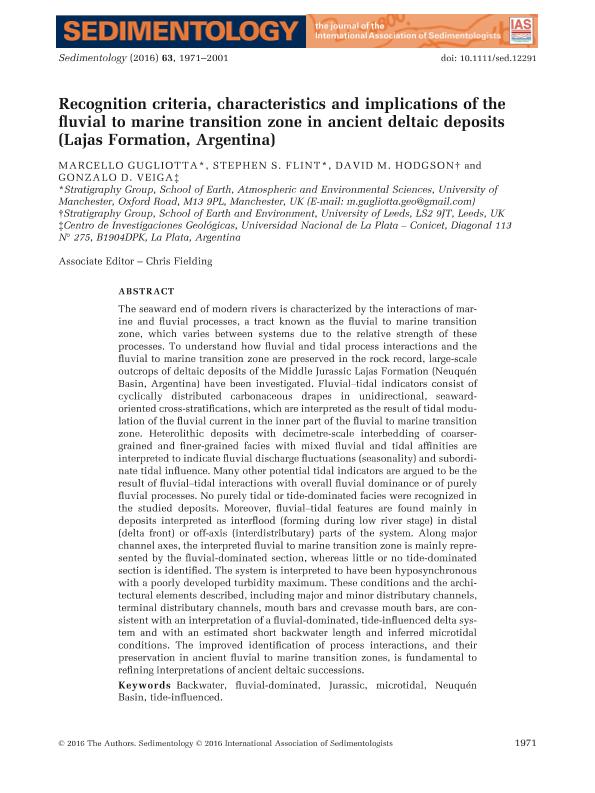Mostrar el registro sencillo del ítem
dc.contributor.author
Gugliotta, Marcello
dc.contributor.author
Flint, Stephen S.
dc.contributor.author
Hodgson, David M.
dc.contributor.author
Veiga, Gonzalo Diego

dc.date.available
2018-06-19T16:40:22Z
dc.date.issued
2016-12
dc.identifier.citation
Gugliotta, Marcello; Flint, Stephen S.; Hodgson, David M.; Veiga, Gonzalo Diego; Recognition criteria, characteristics and implications of the fluvial to marine transition zone in ancient deltaic deposits (Lajas Formation, Argentina); Wiley Blackwell Publishing, Inc; Sedimentology; 63; 7; 12-2016; 1971-2001
dc.identifier.issn
0037-0746
dc.identifier.uri
http://hdl.handle.net/11336/49292
dc.description.abstract
The seaward end of modern rivers is characterized by the interactions of marine and fluvial processes, a tract known as the fluvial to marine transition zone, which varies between systems due to the relative strength of these processes. To understand how fluvial and tidal process interactions and the fluvial to marine transition zone are preserved in the rock record, large-scale outcrops of deltaic deposits of the Middle Jurassic Lajas Formation (Neuquén Basin, Argentina) have been investigated. Fluvial–tidal indicators consist of cyclically distributed carbonaceous drapes in unidirectional, seaward-oriented cross-stratifications, which are interpreted as the result of tidal modulation of the fluvial current in the inner part of the fluvial to marine transition zone. Heterolithic deposits with decimetre-scale interbedding of coarser-grained and finer-grained facies with mixed fluvial and tidal affinities are interpreted to indicate fluvial discharge fluctuations (seasonality) and subordinate tidal influence. Many other potential tidal indicators are argued to be the result of fluvial–tidal interactions with overall fluvial dominance or of purely fluvial processes. No purely tidal or tide-dominated facies were recognized in the studied deposits. Moreover, fluvial–tidal features are found mainly in deposits interpreted as interflood (forming during low river stage) in distal (delta front) or off-axis (interdistributary) parts of the system. Along major channel axes, the interpreted fluvial to marine transition zone is mainly represented by the fluvial-dominated section, whereas little or no tide-dominated section is identified. The system is interpreted to have been hyposynchronous with a poorly developed turbidity maximum. These conditions and the architectural elements described, including major and minor distributary channels, terminal distributary channels, mouth bars and crevasse mouth bars, are consistent with an interpretation of a fluvial-dominated, tide-influenced delta system and with an estimated short backwater length and inferred microtidal conditions. The improved identification of process interactions, and their preservation in ancient fluvial to marine transition zones, is fundamental to refining interpretations of ancient deltaic successions.
dc.format
application/pdf
dc.language.iso
eng
dc.publisher
Wiley Blackwell Publishing, Inc

dc.rights
info:eu-repo/semantics/openAccess
dc.rights.uri
https://creativecommons.org/licenses/by-nc-sa/2.5/ar/
dc.subject
Backwater
dc.subject
Fluvial-Dominated
dc.subject
Jurassic
dc.subject
Microtidal
dc.subject
NeuquÉN Basin
dc.subject
Tide-Influenced
dc.subject.classification
Meteorología y Ciencias Atmosféricas

dc.subject.classification
Ciencias de la Tierra y relacionadas con el Medio Ambiente

dc.subject.classification
CIENCIAS NATURALES Y EXACTAS

dc.title
Recognition criteria, characteristics and implications of the fluvial to marine transition zone in ancient deltaic deposits (Lajas Formation, Argentina)
dc.type
info:eu-repo/semantics/article
dc.type
info:ar-repo/semantics/artículo
dc.type
info:eu-repo/semantics/publishedVersion
dc.date.updated
2018-06-18T21:20:45Z
dc.journal.volume
63
dc.journal.number
7
dc.journal.pagination
1971-2001
dc.journal.pais
Reino Unido

dc.journal.ciudad
Londres
dc.description.fil
Fil: Gugliotta, Marcello. University of Manchester; Reino Unido
dc.description.fil
Fil: Flint, Stephen S.. University of Manchester; Reino Unido
dc.description.fil
Fil: Hodgson, David M.. University of Leed; Reino Unido
dc.description.fil
Fil: Veiga, Gonzalo Diego. Consejo Nacional de Investigaciones Científicas y Técnicas. Centro Científico Tecnológico Conicet - La Plata. Centro de Investigaciones Geológicas. Universidad Nacional de La Plata. Facultad de Ciencias Naturales y Museo. Centro de Investigaciones Geológicas; Argentina
dc.journal.title
Sedimentology

dc.relation.alternativeid
info:eu-repo/semantics/altIdentifier/doi/http://dx.doi.org/10.1111/sed.12291
dc.relation.alternativeid
info:eu-repo/semantics/altIdentifier/url/https://onlinelibrary.wiley.com/doi/abs/10.1111/sed.12291
Archivos asociados
